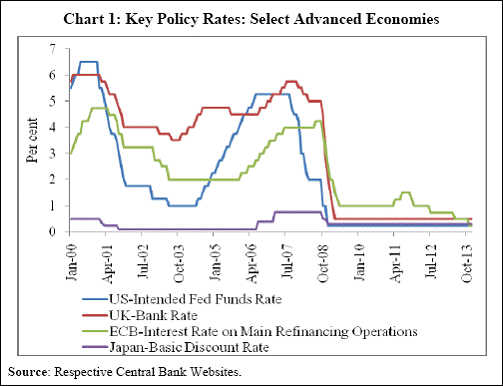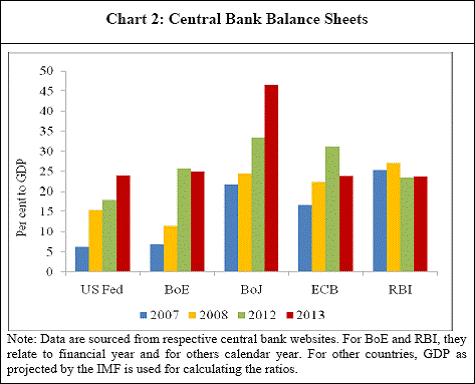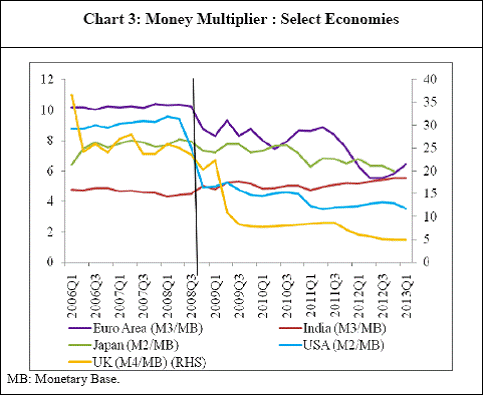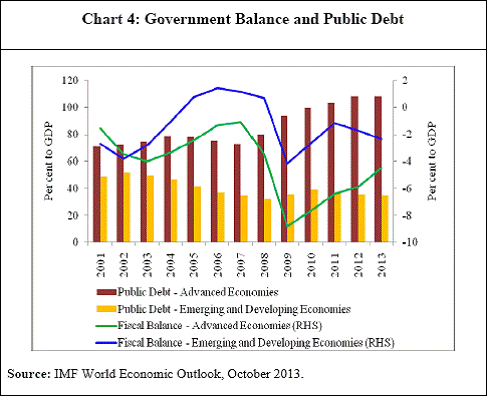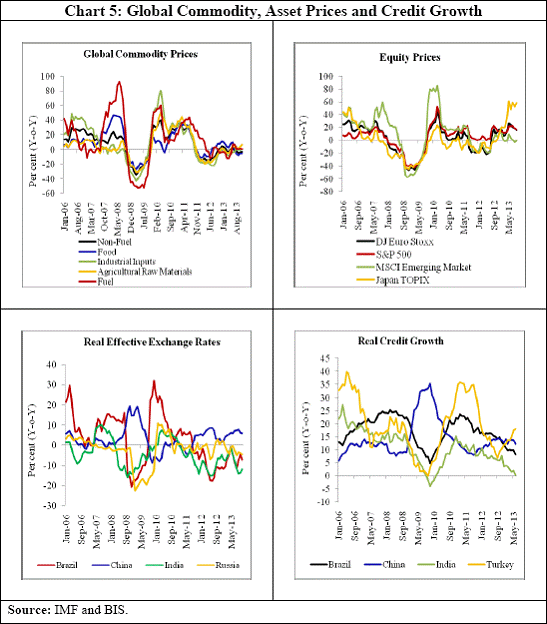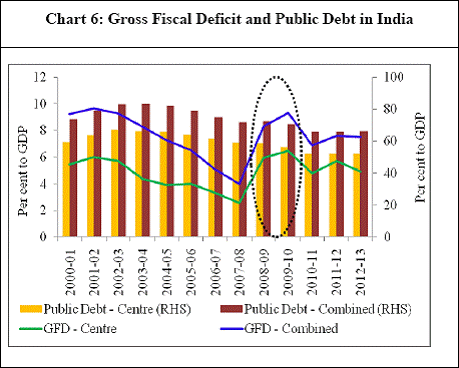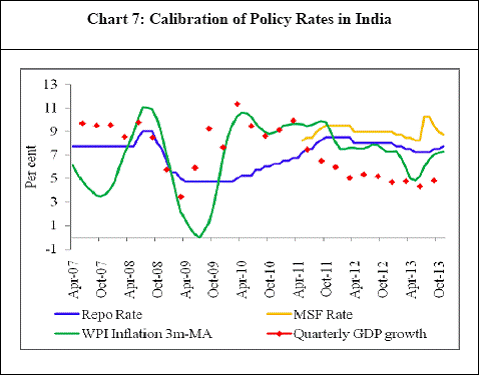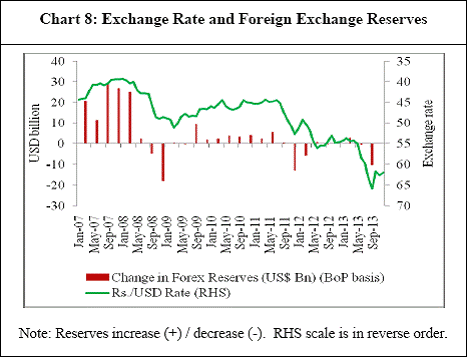 IST,
IST,


Unconventional Monetary Policy: The Indian Experience with Crisis Response and Policy Exit
Shri Deepak Mohanty, Executive Director, Reserve Bank of India
delivered-on ડિસે 26, 2013
I thank Principal Uma Subramaniam for this opportunity to interact with you on unconventional monetary policy. The seminar is topical and timely. It is now 5 years since the collapse of the Lehman Brothers in September 2008, which evoked unprecedented monetary policy activism – both conventional and unconventional - across the advanced and emerging market economies (EMEs). It is for the first time on December 18, 2013 that the US Fed announced concrete measures to exit from unconventional monetary policy in a calibrated manner starting January 2014. The Indian economy like other EMEs was affected both by the global financial crisis post-Lehman and the announcement of likely exit by the US Fed in May 2013. We also resorted to both conventional and unconventional policies not only in response to the crisis but also to the announcement of exit, though there were qualitative differences in these responses. Against this backdrop, I will begin by distinguishing unconventional monetary policy from conventional policy, highlight the contours of unconventional policies in major advance economies and review the impact of such policies. I will then turn to the impact on India and our monetary policy response. I will end by drawing a few broad conclusions. Conventional and Unconventional Monetary Policy Conventional monetary policy is understood as central banks operating with a short-term policy interest rate in the money market to signal the stance of monetary policy and in the process influence the term structure of market interest rates to achieve the objectives of price stability with sustainable growth. Price stability is not an end in itself. Price stability, defined as a low and stable inflation, is considered a prerequisite for sustainable growth over the medium-term. It is believed that there is no trade-off between growth and inflation over the medium-term. Even countries which have chosen inflation targeting framework try to stabilise output around its potential and inflation around its target level. Hence, normally in the event of a shock when either or both the parameters drift from their targets, the objective is to bring it back to target over the medium-term. However, conventional monetary policy has a limiting condition of ‘zero lower bond’. For example, in the event of an extreme shock, as it happened during the global financial crisis, when policy rates were brought down close to zero, further monetary stimulus was not possible through conventional monetary policy. When central banks look beyond their traditional instrument of policy interest rate, monetary policy takes an unconventional character. It essentially means using quantity instruments for expanding the balance sheet of the central bank. It can take different forms: quantitative easing (QE) through direct long-term asset purchase by the central bank, credit easing (CE) by the central bank directly intervening in a particular segment of the credit market. Both QE and CE can be accompanied by dilution of collateral standards by the central bank expanding the list of collateral beyond its traditional preference for low risk sovereign bonds. Unconventional monetary policy is invariably accompanied by forward guidance regarding the future path of monetary policy to work on the expectations channel. This is because the efficacies of asset purchases programme depend on the behaviour of market participants and financial entities. It is likely that market participants may not alter their behaviour without knowing what the central bank will do in the future with regard to these instruments. In the event of a crisis, it is not unusual for central banks to expand their balance sheets. The greatest received wisdom in central banking is the lender of last resort (LOLR) function based on the Bagehot principle that, “the central bank should lend freely against good collateral at a penal rate”1 . In fact, many early central banks including the US Fed were instituted to largely discharge this function. Monetary policy as we understand today was alien then. It is a different matter that the recent global financial crisis tested the limits of Bagehot principle as never before. Contours of Unconventional Monetary Policy Let me now turn to how the US Fed, the European Central Bank (ECB), the Bank of England (BoE) and the Bank of Japan (BoJ) unveiled their unconventional monetary policies. I may mention that the BoJ was using unconventional monetary policy much earlier as Japan went into prolonged deflation from the late 1990s. The global financial crisis which erupted with collapse of major financial institutions in advanced economies was unprecedented in its scale. Not only did it lead to a sharp decline in asset prices, freezing of credit markets, and the loss of confidence in the building blocks of the financial system, its impact was magnified through quick transmission to other economies as well. Monetary authorities in the advanced economies were the first to resort to aggressive monetary easing first by reducing policy rates. However, key channels of conventional monetary policy were severely impaired during the crisis as policy rates in most advanced economies approached zero lower bound (Chart 1). Taking cognisance of the severity of the crisis and concerns of economic recession, central banks used their balance sheets in unconventional ways to augment liquidity (Table 1). The QE programmes initially attempted to alleviate financial market distress, but this purpose soon broadened to include achieving inflation targets, stimulating the real economy, and containing the European sovereign debt crisis (Fawley and Neely, 2013)2. Now let us discuss a little about the rationale for unconventional policies undertaken across major economies.
In the US, immediately after the collapse of Lehman Brothers, when slow growth and high unemployment emerged as major concerns, the Fed announced the policy of quantitative easing (QE) in November 2008. The first two rounds of QEs reactivated financial markets, but failed to spur growth. Under ‘Operation Twist’ instituted in September 2011, the Fed took initiative of buying longer-term Treasuries and simultaneously selling some of the shorter-dated securities to bring down long-term interest rates which continued till December 2012. With a view to putting in place a stronger version QE, it launched QE3 in September 2012. Under QE3, the Fed started purchasing US$85 billion of fixed-income securities per month. The Fed intended to keep QE3 in effect until unemployment falls to 6.5 per cent or inflation rises to 2.5 per cent. In addition to QE3, the Fed gave a forward guidance that it would keep short-term rates low through 2015. As economic parameters showed improvement, the Fed started talking about exit, popularly known as the tapering of bond buying in May 2013. Subsequently, it announced to slow the pace of the bond buying program by US$ 10 billion per month from January 2014. In the UK, after reducing the policy rate (i.e., Bank Rate) to 0.5 per cent in March 2009, the Bank of England (BoE) started its asset purchase programmes which consisted almost exclusively of government bonds from the non-bank private sector. Subsequently, the Funding for Lending Scheme (FLS) was put in place in July 2012 with the aim of incentivising banks and building societies to boost their lending to the UK real economy3. Japan’s economy had deteriorated for nearly 15 years under the threat of deflation. To overcome deflation, the Bank of Japan (BoJ) engaged in a wide range of monetary easing efforts − including the implementation of the zero interest rate policy, the quantitative easing policy and comprehensive monetary easing, but there have been no easily derived concrete results4. Following the crisis, the BoJ embarked on an ambitious asset purchase program to combat deflation. In October 2012, it announced purchase of Japanese government bonds (JGBs), commercial paper, corporate bonds, exchange traded funds (ETF), Japanese real estate investment trusts (J-REITS). In April 2013, BoJ announced Quantitative and Qualitative Monetary Easing Program under which it purchases JGBs, ETFs and J-REITs with the goal of increasing the monetary base by 60-70 trillion JPY annually, increasing the average maturity of JGBs held from three to seven years and meeting the 2 per cent inflation target in about two years. In the euro area, concerns over counter-party risk eventually led to drying up of interbank lending by early 2009. The European Central Bank (ECB) responded in May 2009, by reducing its main refinancing rate to 1 per cent and by introducing 12-month LTROs and the covered bond purchase program (CBPP). The ECB substantially extended its liquidity provision by offering unlimited longer-term refinancing operations. The ECB also purchased some securities outright in distressed markets through its securities markets program (SMP), which was, however, later replaced by the pledge to intervene more decisively through Outright Monetary Transactions (OMTs). The unconventional measures undertaken have involved extraordinary central bank lending, expanding central bank balance sheets substantially (Chart 2). We learn from text books and the inflation experiences of the 1970s that a sharp increase in base money could be inflationary. On the contrary, in the current episode inflation declined below target levels in many advanced countries. Partly the explanation lies in the fact that despite such increase in the size of balance sheets, broad money supply did not expand significantly. This was due to perceptible decline in money multiplier on account of banks building up cash reserves on being risk averse and to conserve on required capital rather than lending to the real economy (Chart 3). Moreover, with interest rates at near zero level, the opportunity costs of holding money for the money holding sector also fell. Another interesting explanation is that inflation expectations remained well anchored, meaning once economic entities believe that inflation will not go up it does not go up. Further, with the economy operating below its capacity the scope for inflation from wage increase is not there. While consumer price inflation may not rise in the short run, it cannot be presumed that asset price inflation will not go up given the excess liquidity. The large scale economic downturn accompanying the financial crisis also led to activation of counter-cyclical fiscal policy of unprecedented magnitude. The fiscal measures focused on improving the balance sheet of the financial and corporate sectors as reflected in large scale bailouts in the US and other advanced economies. Reflecting such fiscal stimulus measures, advanced economies witnessed significant deterioration in their fiscal position as reflected in high public debt to GDP ratios (Chart 4). Let me now turn to the experience of EMEs. Experience of EMEs Initially, it was viewed that EMEs would remain insulated from global financial meltdown on the back of the significant buffers they have built over the years, which included substantial foreign exchange reserves, improved policy frameworks and generally robust banking sector and corporate balance sheets. However, as the crisis deepened following the failure of Lehman Brothers and resulted in heightened risk aversion and global deleveraging, the EMEs were also affected in varying degrees. The contagion from the global financial crisis also warranted swift monetary and fiscal policy responses in EMEs with a view to ensuring orderly functioning of markets, preserving financial stability, and moderating its adverse effects on growth. In the process, their policy responses became more synchronised with global efforts (Mohanty, 2011)5. While both developed economies and EMEs resorted to conventional and unconventional monetary measures, there were certain differences in terms of their timing, types and magnitudes. First, while in the advanced economies the switchover was from conventional monetary tools to unconventional measures due to policy rates approaching zero, in many EMEs, unconventional foreign exchange easing and domestic liquidity augmenting measures preceded the conventional measures of policy rate cuts. Second, while central banks in EMEs relied mostly on direct instruments such as reserve requirements to ease domestic liquidity, central banks in advanced countries resorted to various liquidity providing operations through relaxation of counter-parties, collaterals and maturity. Third, central banks in advanced countries extensively used credit and quantitative easing measures which led to large expansion of their balance sheets unlike in EMEs. Fourth, while in advanced economies fiscal support aimed at rescuing the financial sector from the crisis situation, in EMEs they were generally meant to address the deficiency in aggregate demand. Let me now turn to some of the consequences of unconventional policy. Impact of Unconventional Policies As most of the unconventional monetary policy measures were undertaken keeping in view the domestic economies, the attendant increase in global liquidity appears to have impacted a range of asset classes in both advanced and emerging economies (Chart 5). There are studies which find significant impact of QE. They suggest reduction in US treasury yields around 100 basis points, corporate bond yields by 80 basis points, and reduction in the range of 20-80 basis points in other advanced economies6. In case of some EMEs, the evidence suggested high capital inflow pressure, rapid domestic credit growth and domestic inflationary pressures. Furthermore, indications about the possible withdrawal since the talk about US taper in May 2013 has caused volatility in financial markets in EMEs and impacted currency valuations as capital retreated back to the US in anticipation of higher interest rates. EMEs, particularly with large current account and fiscal deficits, were severely impacted. Let me turn to our experience with the crisis, and now with the talk of taper. Indian Experience with the Crisis and Policy Exit Until the emergence of the global crisis, India had experienced a phase of high growth along with low and stable inflation. Growth was largely driven by high domestic demand - growing domestic investment financed mostly by domestic savings and sustained consumption demand. Sequential financial sector reforms, rule-based fiscal policy and forward looking monetary policy together contributed to the overall improved macroeconomic performance. Following the emergence of the crisis, India, initially remained somewhat insulated to the global developments, but eventually was impacted significantly through all the channels – financial, real and more importantly, the confidence channel (Subbarao, 2009)7. This could be attributed to the global nature of the crisis on the one hand and accelerated trade and financial integration of the Indian economy with the world on the other. The impact of the crisis was first visible on India’s financial markets in the form of tightening of liquidity and higher volatility in all market segments along with sharp decline in stock prices. Risk aversion on the part of global investors resulted in moderation in capital inflows and exchange rate depreciation. Credit growth decelerated reflecting weakening business confidence. Growth, which was already on a cyclical moderation in the first half of 2008-09, decelerated significantly during the second half. As a result, growth declined to 6.7 per cent in 2008-09 from the preceding 5-year average of 8.7 per cent per annum (Table 2). Restoring normalcy in financial markets, ensuring normal flow of credit to productive sectors of the economy as well as limiting the adverse impact on the real sector of the economy assumed policy priority. The Reserve Bank, like most other central banks, took a number of conventional and unconventional measures to limit the adverse impact of the contagion on the Indian financial markets and the economy. These included augmenting domestic and foreign exchange liquidity and a sharp reduction in the policy rate. The Reserve Bank used multiple instruments such as the liquidity adjustment facility (LAF), open market operations (OMO), cash reserve ratio (CRR) and securities under the market stabilisation scheme (MSS) to augment the liquidity in the system. These measures were supported by fiscal stimulus packages which raised the fiscal deficit of the Central Government by about 3.5 per cent of GDP to 6.0 per cent in 2008-09 (Chart 6). On the back of substantial monetary and fiscal stimulus, growth bounced back quickly. However, inflation also picked up. Consequently, the policy focus shifted to exit from accommodative monetary policy in a calibrated manner starting in October 2009. To begin with all special liquidity measures were withdrawn which was followed by hikes in policy rate. As the real policy rate turned positive it started to have an impact on inflation. Going into the financial year 2012-13, growth declined and headline WPI inflation showed a clear sign of moderation. This prompted the Reserve Bank to reduce the policy rate (Chart 7). As the economic conditions appeared to be stabilising, volatility in the financial market returned following the announcement in May 2013 of the Fed’s intention of likely tapering of QE. This prompted the Reserve Bank to resort to somewhat unconventional monetary policy measures besides drawing down of foreign exchange reserves to meet the immediate shortfall (Chart 8). Let me give you the flavour of key measures.
As portfolio capital outflows waned and BoP improved, stability returned to the foreign exchange market. This prompted the Reserve Bank to unwind the bulk of the exceptional measures and normalise monetary policy by restoring the policy interest rate corridor to its original position and the repo rate to its signalling role of policy. Though the policy repo rate was increased by 25 basis points each in September and November 2013, this was more on considerations of emerging growth and inflation balance. Conclusion Let me conclude. First, the global financial crisis triggered unprecedented policy activism by advance country central banks. They resorted to unconventional monetary policy of the nature and scale unthinkable hitherto. Second, as we complete over 5 years of unconventional monetary policy of QE and CE, the question is: did it succeed? While it is too early to say, opinion remains divided. Thus far, with unconventional policies, the central banks have been far less successful in stimulating growth8. While it may not have improved general monetary transmission and prompted sustainable recovery, it did have significant impact on the financial market. The counterfactual of what would have happened without QE is not known? In any case, it seems to have prevented a deeper recession. Third, the spillover effect of QE on commodity markets and emerging market economies (EMEs) has been significant. This has resulted in increased volatility of capital flows and elevated asset prices. The initiation of exit from QE has also created additional macroeconomic challenges for EMEs including India. Fourth, the Indian economy and financial markets were significantly impacted by the global financial crisis and the recent signalling of exit from QE by the Fed. This prompted the Reserve Bank to resort to both conventional and unconventional monetary policy alongside other regulatory policies to stabilise markets. Finally, while the exit from QE increases uncertainties in the financial market, it is increasingly felt that continuation of unconventional monetary policy for long could create risks in the global economy it sought to address by preventing deleveraging and appropriate pricing of risks. In addition, the current policy response has increased sovereign risk in a number of countries which circumscribes the ability of policy to cushion further unexpected shocks. Thank you. * Speech by Shri Deepak Mohanty, Executive Director, Reserve Bank of India at the Reserve Bank Staff College (RBSC), Chennai, December 26, 2013. The assistance provided by Binod B. Bhoi and Rajeev Jain in preparation of this paper is acknowledged. 1Bagehot Walter (1873), Lombard Street: A Description of the Money Market, King &Co., London; reprinted Wiley, New York 1999. 2Fawley, Brett W. and Christopher J. Neely (2013 ), “Four Stories of Quantitative Easing”, Federal Reserve Bank of St. Louis Review, January/February, Vol. 95, No. 1. 3Bank of England (2012), “The Funding for Lending Scheme”, Quarterly Bulletin 2012 Q4. 4Kuroda, Haruhiko (2013), “Quantitative and Qualitative Monetary Easing”, Speech at a Meeting held by the Yomiuri International Economic Society in Tokyo, April 12. 5Mohanty, Deepak (2011), “Lessons for Monetary Policy from the Global Financial Crisis: An Emerging Market Perspective”, RBI Bulletin, April. 6Chen, Q., A. Filardo, D. He and F. Zhu (2012), “International Spillovers of Central Bank Balance Sheet Policies”, in BIS Papers No. 66. 7Subbarao, D. (2009), “Impact of the Global Financial Crisis on India: Collateral Damage and Response”, Speech delivered at the Symposium on “The Global Economic Crisis and Challenges for the Asian Economy in a Changing World” organised by the Institute for International Monetary Affairs, Tokyo, February 18. 8Rajan, Raghuram (2013), “A Step in the Dark: Unconventional Monetary Policy after the Crisis”, Andrew Crockett Memorial Lecture delivered at the BIS on June 23. |
||||||||||||||||||||||||||||||||||||||||
પેજની છેલ્લી અપડેટની તારીખ:






